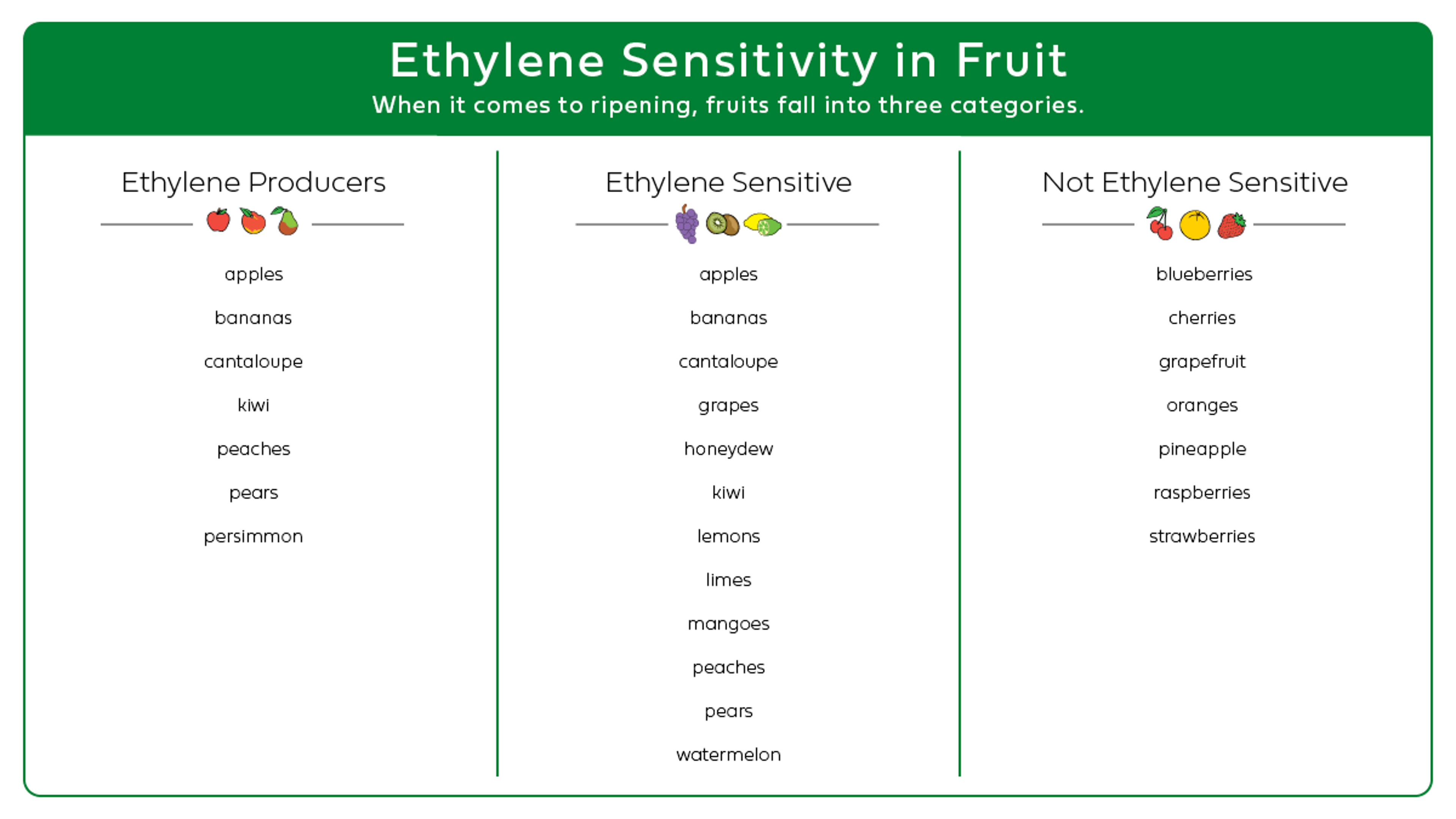How to Make Fruits Stay Fresh Longer
Are you serious about extending the lifespan of your fruits? Here's a fresh guide to show you how.
Jan 30, 2024
When it comes to keeping your fruit fresh, or even ripening them, you consider yourself pretty savvy: You throw everything in the fridge crisper drawer — that's where they're all supposed to go, right? Isn't that what Old MacDonald himself would do?
Well, actually, ee-eye, ee-eye-NO.
Yes, that compartment can keep fruits and veggies fresh...that is, some produce, sometimes. Some belong in the crisper, some just need refrigeration, and others can sit out on the kitchen counter for weeks. WEEKS! Sounds preposterous, but it's true.
And to make matters even more potentially rotten, not all produce get along. (Ever check out what goes on at the dog park? The discourse between apples and cabbage can get just as rough.)
Here's what you need to keep in mind: Each type of produce has its own life expectancy, potentially shortened or extended by you. Some fruits do best out in the open at room temperature, others need chilling, and still others need chilling in a box. Some require complete, solitary confinement, and others can handle semi-confinement. And, finally, some emit and thrive on ethylene gas, whereas others exposed to the gas decay faster.
For the sake of your wallet — and the planet — we know you want to avoid food waste. To wit, here's our guide to keeping fruit fresh longer.

Ethylene producers: apples, bananas, cantaloupe, kiwi, peaches, pears, persimmon.
Ethylene sensitive: apples, bananas, cantaloupe, grapes, honeydew, kiwi, lemons, limes, mangoes, peaches, pears, watermelon
Not ethylene sensitive: blueberries, cherries, grapefruit, oranges, pineapple, raspberries, strawberries.
Apples
Apples
Shop : Apple Medley from Harry & David
Apples and Aged White Cheddar from Harry & David
Apple and Honey Gift from Harry & David
Steps to "ripehood": Did you just bring home green apples that aren't supposed to be green? No worries, you can still bring them to fruition. For best results, store them in a loosely sealed paper bag, ideally in the fridge (or skip the bag and pop the fruit in the crisper drawer).
The gas factor: Apples are ethylene producers, so bunking them with other gassy fruits, such as bananas, speeds up ripening. Once ripe, though, know that keeping apples in such a gaseous state actually speeds up their demise.
Keeping them fresh: Apples placed in a bowl, where folks will no doubt snap them up, can bring a nice decorative touch to a home. Leave them out more than a few days, though, and their next home will be the compost heap. But keep them in a cold, dark place — 31 to 35 degrees Fahrenheit even — and apples can last for months.
Parting is such sweet sour: Apples are pretty forthcoming when it comes to revealing their mortality: brown spots, bruising, soft spots, wrinkled skin. Apples: They're just like us.
Shop : Apple Medley from Harry & David
Apples and Aged White Cheddar from Harry & David
Apple and Honey Gift from Harry & David
Citrus
Oranges, grapefruits, lemons, limes
Citrus
Oranges, grapefruits, lemons, limes
Shop : Winter Citrus Trio from Harry & David
Florida Indian River Ruby Red Grapefruit from Harry & David
Citrus Fruit-of-the-Month Club® Collection from Harry & David
A decorative fruit: For home interior design types, nothing livens up a stark white kitchen like bowls of ripe lemons or limes (oranges and grapefruit can work too). After a week or two, though, you'll need to either consume this décor or move the fruit to its next resting place.
Keeping them fresh: Citrus can hang out in the refrigerator for a couple of weeks. In the crisper, they can remain viable for a month or so. If you zest them, put them directly in the crisper but eat within 24 hours; otherwise, they start to harden and dry out, and mold will form.
The gas factor: Oranges and grapefruits aren't sensitive to ethylene gas, so you can store them in containers with “gassy" fruits like apples, pears, and bananas. However, lemons and limes are ethylene sensitive and will decay faster if stored with the "gassies." Separate accordingly.
Parting is such sweet sour: Signs your citrus are entering the afterlife include mold, squishiness, discoloration, and loss of that sweet, citrusy smell.
Shop : Winter Citrus Trio from Harry & David
Florida Indian River Ruby Red Grapefruit from Harry & David
Citrus Fruit-of-the-Month Club® Collection from Harry & David
Kiwis
Kiwis
Shop : Manhattan Fruitier Classic Fruit Basket from Harry & David
Steps to "ripehood": Ripe kiwis are soft, round, and brown, and smell sweet. If yours aren't, no worries — a few days inside at room temperature will help get them there.
The gas factor: Kiwis are ethylene emitters, so putting them in a paper bag, ideally with other gassy fruits, will speed up ripening. Once ripe, though, keep the kiwis away from ethylene emitters, since that can lead to premature spoilage.
Keeping them fresh: Ripe kiwi will do fine on the counter at room temperature for three to five days (assuming you keep them out of direct sunlight). To keep them fresh for up to four weeks, drop them in a plastic bag and lay them to rest in the fridge crisper.
Parting is such sweet sour: Naturally, as always, mold is a deal breaker. Beyond that, inspect for any cosmetic defects, along with soft spots or squishiness.
Shop : Manhattan Fruitier Classic Fruit Basket from Harry & David
Mangoes
Mangoes
Shop : Tree-Ripened Mangoes from Harry & David
Dried Mangoes from Harry & David
Mango Salsa from Harry & David
Steps to "ripehood": A green mango means an un-ripened mango. Get it to the finish line by putting it in a paper bag and storing it at room temperature. Over several days, it will become sweeter and softer.
Keeping them fresh: You go to all that trouble to ripen your mango and now you're not yet ready to eat it? (Sigh.) Fine. You can store it in the fridge for roughly five days before the fruit starts going south.
The gas factor: Such a biggish, rugged-looking fruit and yet...gas sensitive. Keep mangoes away from the gas emitters.
Parting is such sweet sour: Mangoes are ready to go when they start forming brown spots or mold. An unpleasant smell is also a red flag.
Shop : Tree-Ripened Mangoes from Harry & David
Dried Mangoes from Harry & David
Mango Salsa from Harry & David
Pears
Pears
Shop : Royal Riviera® Gold Pear Gift from Harry & David
Royal Riviera™ Vinaigrette and Pears with Blue Cheese from Harry & David
Giant Royal Riviera® Pear Duo from Harry & David
Ripening: Should you bring home a pear yet to reach its prime, you must cater to its every whim. OK, that's an embellishment. But unripened pears must first sit out — on the kitchen counter, perhaps — at room temperature for four to seven days. Give them a squeeze every day. Once they soften a bit, you can either eat them or...
Keeping them fresh: Pop them in the crisper! Yes, the pear is a fruit that prospers in that fridge humidity drawer.
The gas factor: The pear is an ethylene gas emitter, so store it with other “gassy" fruits or in solitary confinement (a plastic bag will do).
Parting is such sweet sour: After ripening, pears will last a maximum of two weeks. After that, they become squishy, brown, and less tasty.
Shop : Royal Riviera® Gold Pear Gift from Harry & David
Royal Riviera™ Vinaigrette and Pears with Blue Cheese from Harry & David
Giant Royal Riviera® Pear Duo from Harry & David
Persimmons
Persimmons
Steps to "ripehood": A ripe persimmon (Harry & David provides the Fuyu variety) is a bit like a tomato — bright orange and soft to the touch. Persimmons that are still yellow or hard need the paper bag treatment.
The gas factor: Freshly picked persimmons are big ethylene producers — and they love their own gas. Pop them in a paper bag, leave them out at room temperature, and, typically, they'll ripen within a week.
Keeping them fresh: These fruits opt for solitary confinement and will live happily in the refrigerator crisper drawer for a week — maybe as long as a couple of weeks.
Parting is such sweet sour: It's time to bid adieu when your persimmons lose their sweet smell and develop an odor, grow mold, and form a number of soft spots and wrinkled skin.
Pineapple
Pineapple
It ripens while looking pretty: Like citrus, pineapples are another top “display fruit" (a category we just made up), meaning you can install one as, for instance, a table centerpiece. Showing off your pineapple also works from a ripening standpoint, since you can leave it out in the open for several days.
Keeping it fresh: Indeed, leaving a pineapple out in the open at room temperature keeps the fruit fresh for days. Setting it in the fridge, however, extends its lifespan several more days.
The gas factor: If pineapple-as-décor does nothing for you — you just want to eat it already!—don't expect hang time with gassy fruits to help: Pineapples aren't very ethylene sensitive.
Parting is such sweet sour: A rotting pineapple makes no effort to hide its malaise. It may start turning a brown/gray color; it may become slimy, its bottom wet, the leaves turning brown. And that sweet signature aroma gives way to something more pungent.
Stone Fruits
Cherries, peaches, plums
Stone Fruits
Cherries, peaches, plums
Shop : Plump-Sweet Cherries and Chocolate-Covered Cherries from Harry & David
Steps to "ripehood": First off, what in God's green orchards do these three fruits have in common so as to be deemed stone fruits? Thanks for asking: A stone fruit sports a fleshy exterior/interior and a pit or stone in the center.
As for ripening stone fruits, cherries are pretty much ripe when you buy them, but they and the other two fruits can be pushed further toward a state of ripeness...
The gas factor: ...by dropping them ino a paper bag with an unripe banana or apple, folding the bag closed, and storing the fruit at room temperature. Yes, that's right: These stone fruits are ethylene-gas sensitive.
Keeping them fresh: Once ripe, all three stone fruits need refrigeration.
Cherries: Spread them out on a flat surface (use paper towels if you need to layer them). Do not wash until you're ready to eat them, since they absorb water easily. This will keep them fresh for about a week.
Peaches: They'll hold firm for three to five days, roughly.
Plums: Best to keep them in an open container or plastic bag to prevent moisture buildup (which can bring on the mold). Do this and you typically get a week to 10 days of plum freshness.
Parting is such sweet sour: Time to say goodbye to stone fruits when...
Cherries: They're squishy, wrinkled, discolored, and smell bad. A good cherry is firm and plump.
Peaches: They bruise easily, though that doesn't mean the whole fruit has gone bad. Actual issues include mold, squishiness, wrinkles, an odor, and brown insides.
Plums: See cherries.
Shop : Plump-Sweet Cherries and Chocolate-Covered Cherries from Harry & David
Strawberries
Strawberries
Make the ripe start: Your strawberries are nice and dark, and smell strong and sweet. They're ripe. And that's good, since strawberries don't ripen after picking. That means, once home, you need to eat them within a few days or put them into storage mode.
Keeping them fresh: Strawberries are all too happy to host mold spores, so you'll need to keep this fruit cold and dry. In fact, don't even think about washing them before storing them. Just line an airtight container (or the crisper) with a paper towel, drop in the strawberries, and refrigerate.
The gas factor: Hopefully, you've already picked up on how delicate this fruit is. (And, by the way, we have to call it a fruit since strawberries actually aren't berries.) And yet, they're not ethylene sensitive.
Parting is such sweet sour: Follow our guidelines and strawberries should stay fresh for about a week. After that, you may start seeing unpleasantness, such as mold, squishiness, soft spots (especially dark ones), and browning leaves.
So, what's the deal with the crisper drawer?
That drawer or two inside your fridge? If you fall on the novice end of the gourmand spectrum, you may think this is a super-convenient space to store, say, your ale. And while there's nothing wrong with that (and your ale will certainly meet with no harm), the crisper drawer actually serves a specific function.
For certain fruits and vegetables, the crisper drawer, also known as the humidity drawer, provides a secluded space to keep produce in its most ideal state — a place where it can stay freshest longest. The drawer lets you refrigerate fruits and veggies while separating them from other fridge tenants that may emit, say, ethylene gases, which can speed up decay. Plus, there may be humidity controls, allowing you to provide the ideal climate for residing produce.
As a general rule of thumb, use the low-humidity setting for anything that rots easily. That means apples, pears, avocados, melons, or stone fruits. The high-humidity drawer is great for anything that wilts — think thin-skinned vegetables, such as asparagus, or leafy vegetables, such as greens.
Mommy, where do fruit flies come from?
Fruit flies seem to magically appear from nowhere. But, we assure you, they're not supernatural bugs. In fact, like all insects, they hail from the outside world. After that, they either sneak into your home via an open door or window or hitch a ride on incoming fruit. Then it gets really unpleasant.
Have spoiled fruit lying around? The little buggers see rotting produce as the perfect maternity ward — a great place to lay eggs. And, so, this fruit hosts fruit fly nurseries, which result in a swarm of new baby fruit fly residents in your home.
So, how do you get rid of them? An easy DIY solution: Fill a cup or bowl with the lure of apple cider vinegar (they can't resist the scent). Cover tightly with plastic wrap (a rubber band helps) and poke a few tiny holes in the plastic. Fruit flies will check in, but they can't check out.
.svg?q=70&width=384&auto=webp)



























